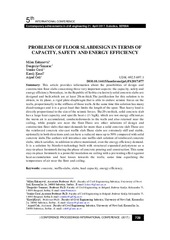Приказ основних података о документу
Problems of floor slab design in terms of capacity, safety and energy efficiency
Problematika projektovanja međuspratnih ploča sa aspekta nosivosti, sigurnosti i energetske efikasnosti
| dc.creator | Kekanović, Milan | |
| dc.creator | Šumarac, Dragoslav | |
| dc.creator | Ćorić, Stanko | |
| dc.creator | Kasaš, Karolj | |
| dc.creator | Čeh, Arpad | |
| dc.date.accessioned | 2019-04-30T13:23:48Z | |
| dc.date.available | 2019-04-30T13:23:48Z | |
| dc.date.issued | 2017 | |
| dc.identifier.uri | https://grafar.grf.bg.ac.rs/handle/123456789/1546 | |
| dc.description.abstract | This article provides information about the possibilities of design and construction floor slabs concerning three very important aspects: the capacity, safety and energy efficiency.Nowadays, in the Republic of Serbia exclusively solid concrete slabs are designed and built,which are at least 20cm thick.The justification for this solution is to obtain, in its plane, a rigid plate-diaphragm that is able to endure seismic forces on the walls, proportionally to the stiffness of those walls.At the same time this solution has many disadvantages and it is a great load that limits the length of the span. That heavy load is directly proportional to the size of the seismic forces. The20 cm thick, solid concrete slab has a large heat capacity, and specific heat c (J / kgK), which are not energy efficient,as the warm air is accumulated, conductedtowards to the walls and also retained near the ceiling, while people are near the floor.There are other solutions of design and construction floor slabs that meet demands far more than a solid concrete slab.These are the reinforced concrete site-cast waffle slab.These slabs are extremely stiff and stable, optionally in both directions and can have a reduced mass up to 50% compared with solid concrete slabs.The authors will introduce one waffle-slab solution of reinforced concrete slabs, which satisfies, in addition to above mentioned, even the energy efficiency demand. It is a solution by Stirofert-technology built with structural expanded polystyrene as a stay-in-place formwork during the phase of concrete pouring and construction. This same stay-in-place formwork is a powerful insulation on ceiling with a preventing effect against heat-accumulation and heat losses towards the walls; same time equalizing the temperature of air near the floor and ceiling. | en |
| dc.publisher | Građevinski fakultet, Subotica | |
| dc.relation | info:eu-repo/grantAgreement/MESTD/Integrated and Interdisciplinary Research (IIR or III)/42012/RS// | |
| dc.rights | openAccess | |
| dc.rights.uri | https://creativecommons.org/licenses/by-sa/4.0/ | |
| dc.source | Zbornik radova 5. međunarodne konferencije Savremena dostignuća u građevinarstvu 2017 | en |
| dc.title | Problems of floor slab design in terms of capacity, safety and energy efficiency | en |
| dc.title | Problematika projektovanja međuspratnih ploča sa aspekta nosivosti, sigurnosti i energetske efikasnosti | sr |
| dc.type | conferenceObject | |
| dc.rights.license | BY-SA | |
| dc.citation.epage | 738 | |
| dc.citation.other | 33: 729-738 | |
| dc.citation.spage | 729 | |
| dc.citation.volume | 33 | |
| dc.description.other | Zbornik radova Građevinskog fakulteta | en |
| dc.identifier.doi | 10.14415/konferencijaGFS2017.077 | |
| dc.identifier.fulltext | https://grafar.grf.bg.ac.rs//bitstream/id/3565/1544.pdf | |
| dc.type.version | publishedVersion |

